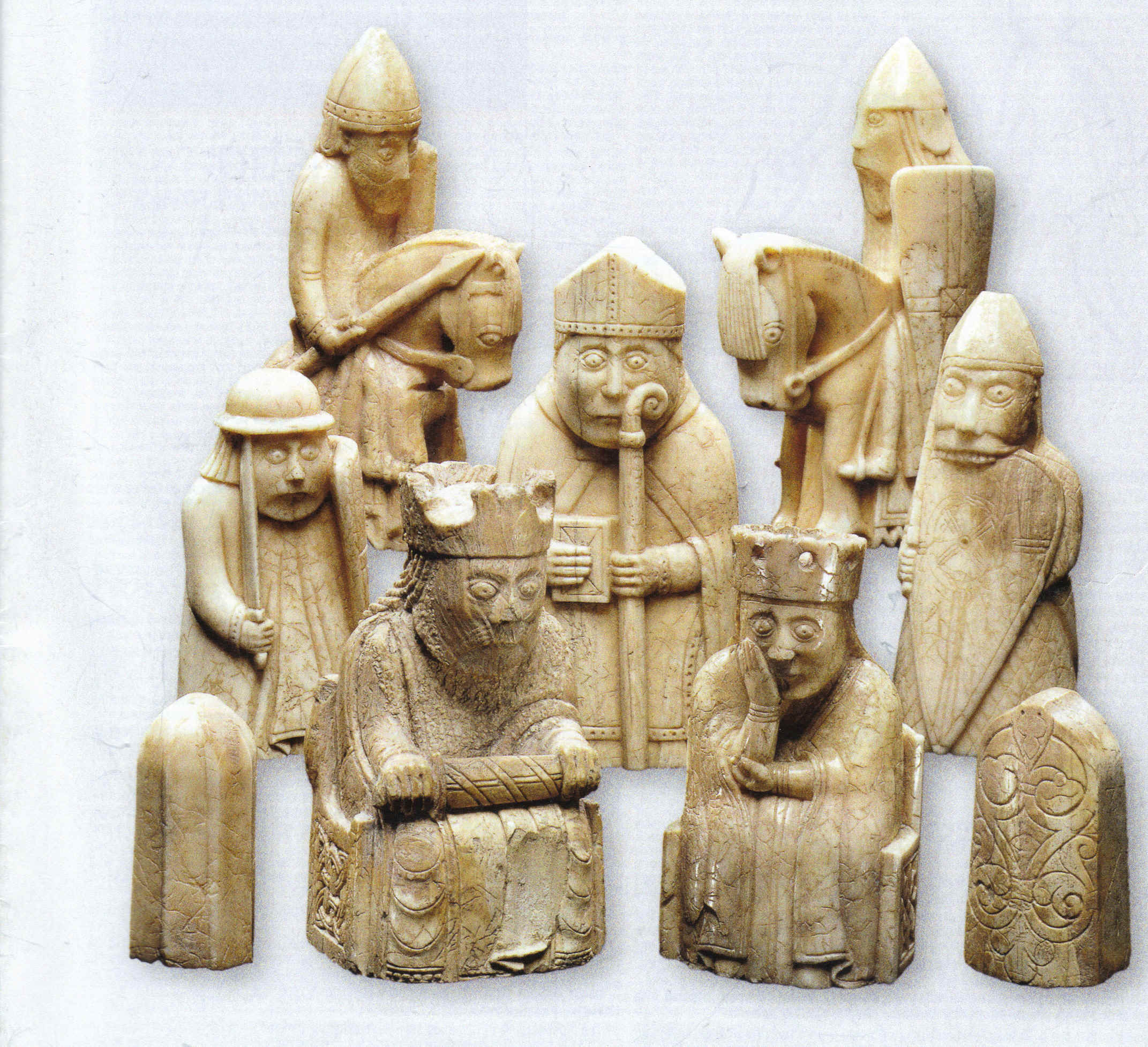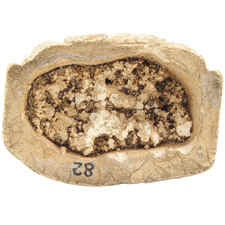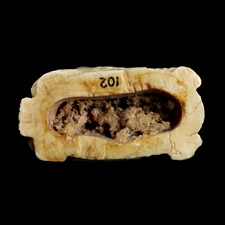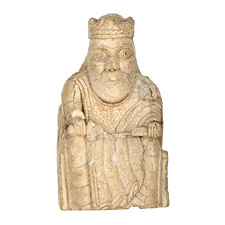|



VISITING
AUTHOR-ARTICLE
MARCH
2011

The
Lewis
Chessman
Forwarded
by Thomas B. Cole, M.D., MPH., JAMA
Page
649 JAMA,
February 16, 2011—Vol 305, No. 7

THE
NORSE SEAFARERS OF THE MIDDLE AGES, ALSO KNOWN as
the Vikings, explored Greenland and North America,
plundered
towns and monasteries along the coasts of Europe,
and established trade routes
throughout the western world. One of their trade routes
stretched east by water from Norway to the Gulf of
Finland,
then overland and downriver through present-day
Russia and across the Black Sea to Constantinople,
capital
of the Byzantine Empire. Another route led to the Hebrides
Islands off the west coast of Scotland, where a
collection
of 93 game pieces of Norse origin was found on the
Isle of Lewis in 1831. Most of the pawns were
missing, but there
were almost enough face pieces to make up four complete
chess sets. The pieces may have been buried in the
dunes by
a merchant or by a person of high rank who hid the
sets during
a time of conflict between local rulers and their
Norwegian
overlords.
Nine
of the Lewis chess pieces are displayed on the
cover. The
rounded arches of the helmets and flowing, leafy
scrollwork are characteristic of the Romanesque
style of European art.
The chess pieces may have been carved in Trondheim,
the political and cultural center of Norway at the
time, using walrus
ivory from Greenland. The design of each piece
reflects its
status in medieval society and on the field of
play. The pawns, faceless
in this set, are analogous to vassals or serfs.
They are the
most numerous of the chess pieces but have the
least tactical value. Next in importance are the
knights on horseback, most useful in the early
phase of the game when many pieces remain
in play, because they can leap over other pieces
to control
the center of the board and limit the opponent's
freedom of
movement. In the center of the group is a bishop
with his prayer
book and staff. Bishops are most effective at the
end of die
game, when fewer pieces remain on the board to
obstruct their
long diagonal movements.
To
either side of the bishop are the warders, who
defend the
fortifications. One of the two warders is a
berserker, a type
of specialist in Norse combat units who would become
so enraged during battle that he would bite his
shield and
attack anyone within reach, whether friend or foe.
Some berserkers
led assaults and others served as bodyguards. Instead
of warders, modern chess sets have pieces that
look like
castle towers, called rooks, to symbolize their
defensive role. Between the pawns in the grouping
on the cover sit
the king and the queen on their thrones. In chess,
if a king
is attacked and cannot escape, the game is over.
The steely
king on the cover grips his short sword in both
hands, as
if to say he will go down fighting. The queen has
more freedom
of movement, and is therefore more dangerous, than
all
of the other chess pieces; but conversely, the
loss of the queen
to an attacker is a severe handicap to the player.
No wonder
she looks so anxious and careworn.
As
the tactics of chess have evolved, the style of
play has often
reflected the social values of the players. An
early version
of chess was played in the Sassanid Empire of
Persia, perhaps as long ago as 600 CE. After the
Muslim conquest of
Persia in the seventh century, chess spread
throughout the
Muslim world and via trade routes to Christian Europe. In the Middle Ages, chess was a popular pastime of European
nobility, along with riding, archery, hawking, and
the
writing of verse, but players were discouraged
from spending
the time to become adept at chess, because it was,
after
all, only a game. In the Age of Enlightenment,
chess was
considered to be an exercise in moral development;
the American author and political theorist Benjamin Franklin wrote
that playing the game was a way to acquire the virtues
of foresight, circumspection, and caution.
By
the 19th century, chess had become an everyman's
game, with
more matches played in coffeehouses than in
palaces or landed
estates. Players with exceptional skill emerged,
and tactical
innovations were publicized in books and journals.
Chess masters
of the early 19th century were most admired for
their ability
to probe weaknesses in the opponent's position.
Players
typically used one or two pieces to mount a quick
attack on
the opposing king, without first taking the time
to move other
pieces into positions of support. To counter these
tactics,
more analytic players shored up their defenses. In
the 20th century,
combinations of moves were planned even further ahead
to establish positional strength and enable coordinated
attacks. At the expert level, the emphasis today
is on refining a winning strategy, rather than on
taking pride in a culturally
commendable or entertaining style. Still, there is
a place
for beauty in the choreography of chess.
Tacticians who specialize
in creating series of moves leading to specific
outcomes
are called chess composers, and their compositions
are played,
like musical scores, by students of the game.

|

|
|
Courtesy
of The British Museum ( http://www.britishmuseum.org
), London, England.
©
The Trustees of the British Museum |
|
The Lewis Chessmen,
probably
made in Norway,
found on the Isle of Lewis,
Outer
Hebrides, Scotland,
circa 1150-1200.
Walrus ivory. Height: 4
to 10.3 cm. |

Studying
and conserving the Lewis Chessmen
The hoard of 82 ivory chess-pieces known as
the Lewis Chessmen was found in 1831 in Ulg on the Isle
of Lewis in the Outer Hebrides in what was
possibly a small, drystone 'subterranean' chamber.
The pieces consist of elaborately worked walrus
ivory and whales' teeth in the forms of seated
kings and queens, mitred bishops, knights on their
mounts, standing warders and pawns in the shape of
obelisks.
When found, some were reported to be stained red.
Recent examination by British Museum scientists
and conservators using optical microscopy did
suggest possible traces of red coloration on some
pieces, but further investigation has
not been able to detect any colourants still
present.
Ivory is very similar to bone in composition,
consisting of a mixture of organic and inorganic
materials: the inorganic part consists of calcium
phosphate in association with carbonate and
fluoride (hydroxyapatite). The organic material is
mainly the protein ossein. Distinguishing between
ivory and bone, and determining the type of ivory
used requires expert examination using a
microscope.
Identification
of the ivory of the Lewis chessmen
Scientific examination of the Lewis chessmen is
ongoing, but recent investigations at the
British Museum have been focused on identifying how
they were shaped and decorated, and what they
are made of.
Using a variable pressure scanning electron
microscope (SEM), scientists at the Museum can see
traces of wear and modifications caused by burial
and damage.
Some of the chessmen are made from whale tooth but
most are made from walrus ivory, the long upper
canine teeth of the Atlantic walrus. Teeth and tusks
have the same physical structures, which consist of
the innermost pulp cavity, dentine, cementum and
outermost enamel.
Walrus ivory structure consists of outer hard
yellowish-white enamel, cementum and two distinct
inner layers of calcareous dentine. The image below
shows this unique structure: the primary
dentine has fine concentric rings whereas the
innermost core of secondary dentine, which is spongy
in appearance but is as hard as the primary, has a
more globular texture, sometimes described as
marbled. The original carvers have maximised the use
of the smoother primary dentine for the carving.
Because of its colour, old walrus ivory is reputed
to be more valuable and sought after for carving
than fresh material. The same structure is present
in both fresh and old walrus ivory; both can be
carved in the same way. SEM examination shows
that many of the Lewis chessmen are made of old
walrus ivory. The ivory has been damaged by
marine gastropods, indicating the walrus was long
dead when the tusks were collected.
Some of the chessmen are made from whale tooth.
Whales have conically shaped teeth with a small
amount of enamel at the tips. The rest of the tooth
is covered by a substance called cementum. The
dentine is deposited in parallel layers which shows
up as concentric rings.
The structure of walrus ivory (and whale tooth)
differs markedly from that of elephant ivory.
Polished cross-sections of elephant ivory dentine
display uniquely characteristic Schreger lines,
often referred to as intersecting arcs or
engine-turnings.
|
The
underside of the king chessman
showing
the characteristic structure
of
walrus ivory in cross-section. |

|
|

|
Traces
of old adhesive showing
on
the base of a knight chessman,
before
treatment. |
| A
king chess-piece showing breaks
between
the primary and secondary
dentine |

|
Conserving
the Lewis Chessmen
All the Lewis chessmen have recently been examined
by British Museum conservators to investigate their
condition and carry out any treatment required for
them to be safely displayed.
Some of them have undergone minor conservation
treatments over the years since their discovery to
stabilise them but on the whole are in relatively
good condition. In some cases these old coatings and
adhesives had changed with time and become more
noticeable or had degraded leaving unsightly remains
visible on the surface.
Ultraviolet light was used to reveal further
evidence of old treatments not visible in normal
light. The materials used in these previous
treatments have been characterised and documented,
and provide an insight into changing approaches to
the selection of conservation materials over the
last century.
Walrus ivory has a distinctive structure with two
distinct inner layers of dentine, which affects the
way in which it deteriorates and this in turn
affects the approach to its conservation. In a few
cases there was evidence of old movement such as
cracks and breaks between the primary and secondary
dentine.
Light cleaning and some stabilization was needed.
Splits and cracks were treated with a dilute
adhesive and areas of loss filled. Only adhesives
and fill materials stable, reversible and also
flexible enough to accommodate slight size
changes in the ivory, were used.
As
a very sensitive material, prolonged exposure to
water can leave ivory brittle and chalky, while acids
readily attack it. It also reacts to changes in
the moisture content of the air. If the
humidity in the environment drops, the ivory loses
moisture and contracts. If the humidity increases,
it absorbs moisture and expands. Fluctuations in
humidity (or exposure to heat) can cause ivory to
crack, split or warp, so the chessmen are kept
in a stable environment of about 40-55% Relative
Humidity and at a temperature of 16-20 ºC.
It is likely that some of the chessmen were once
coloured although analysis has not been able to
detect any colouring agents still present.
Nevertheless, since some colourants are light
sensitive, the lighting within the display-case is
kept at a low level, so any remaining colour will be
preserved.

|